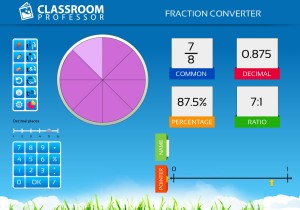I’m going to be a grandfather, this coming August.
This momentous event is not unexpected, since our daughter has been married to her wonderful husband for 3.5 years. Nevertheless, it has made me think again about small children I have a particular interest in, and what happens to them at school. This post is just a touch indulgent, but I invite you to join me in thinking about the qualifications for teaching children.
What do children need from their math teachers? How important is it? If you really were going to be my grandkids’ teacher, these are the questions I’d be keen for you to answer:
Math Teacher Job Interview: Questions for Candidates
- How did you do at math when you were at school?
It’s not important if you were an “A” or a “F” student; you could become a brilliant teacher of math from either starting point. Now, on balance, I’d rather that you got great marks at math, since you obviously “get it” and will be able to understand math more deeply than most. But either way, I’d like an answer to the second part of this question:
- Do you understand why lots of people find math difficult, scary or downright horrible?
To teach students who really don’t understand math, and therefore most likely hate doing math, you need to be able to empathize with them. Did you ever feel that learning math was pointless, illogical, impossible or just plain frustrating? If so, great! Can you put that knowledge to work as you help students who feel that way? If not, are the ways for you to learn what it feels like to students who hate math?
- Do you love math? If not, are you at least enthusiastic about math?
Not everyone loves math. Even math geeks get that. But teachers of math have a responsibility to encourage students who do love it, who will go on to do amazing, important math later in their lives. I have decided to never discourage a student who has, or is developing, a passion for something, anything almost. If a student loves dancing, or BMX bike riding, or astronomy, or writing poetry, I will do everything in my power to support, encourage and promote success for that student in that endeavour. How can you do that in math?
- Which is most important to you: understanding, or correct answers?
We should never pretend that correct answers aren’t important. But just as giving a poor person a fish is a lousy substitute to teaching that person how to catch fish, focusing on correct answers should come after we are sure the student understands the math, never before. Great math teachers have the attitude that correct answers are the product of correct thinking, and in some cases aren’t even that important, providing the student understood the process.
- Do you teach “tricks and shortcuts” to math processes?
This is really the corollary of the previous point. A shortcut (eg, to convert a decimal to a percentage, move the decimal point two places to the right) will lead a non-understanding student to the correct answer, providing (and this is the deal-breaker right here) the student can remember the correct trick to use. But the shortcut or trick will let the student down in situations in which the math is not so obvious, and thinking has to be applied to solve a problem. Good mathematicians do use shortcuts, but that happens way, way, way after they understood why the shortcuts worked.
- How important is memorization of times tables and number facts to you?
Since calculators first became a consumer item, teachers have had a challenge with this question. Do we really need to spend the time that some of us remember from our own school days on learning times tables, or can we now let calculators handle that process? Answer: unless students have fast, accurate, confident recall of basic number facts and times tables, they will be hampered and slowed down by the need to reach for a calculator every time they need one of those facts. If you have to know “13 x 24″, by all means use a calculator – it will be quicker. But if the question is “6 x 7″, recalling the answer quickly will save huge amounts of time and cognitive load.
By the way, to see a series of classroom-tested, systematic workbooks for teaching all the basic facts and times tables in 10 minutes a day, visit our store.
- What math teaching blogs, forums, wikis or Facebook pages do you read?
In most places where teaching is a profession, a certain amount of professional development is required every year. Where once that PD came in the form of visiting academics to run workshops and sessions after school, nowadays it should also include use of online communities and other sites, where other teachers and educators meet to exchange ideas and encourage each other. Some examples from hundreds of great sites:
- Do you use technology to help your students learn math? How?
I already wrote about the necessity of math students knowing their number facts. The way some non-math people talk, this is an “either-or” situation: either you learn times tables by rote, or you use technology. My view: the true answer belongs in the middle somewhere. Yes, students need to learn number facts. No, they don’ t need to use unthinking rote methods (see here for more on this). Yes, they should use technology. A great math classroom will have lots of appropriate technology: calculators, iPads, iPods, laptops, data projector and interactive whiteboard, internet connection (duh!), etc., etc. The technology opens up unlimited possibilities for connecting classroom math to real life math, for using microchip tech to make more complicated math possible, for practising skills using online interactive widgets, and so on and so on.
- Do you assign math homework? What sorts?
Homework is a huge topic which I don’t have space to address adequately here. But for the purposes of this post, let’s agree that homework is a great way to connect your math lessons with parents and other family members. By sending home suitable activities to apply and practise the math being learned in class, you make space for child and parent/grandparent/carer to have conversations about math. My advice: make the homework something every child can succeed on, so that it becomes an enjoyable part of family life, not one of the biggest frustrations. Build in activities for children to talk about math at home, for the benefit of child and adult.
- Do you integrate math into other subjects’ lessons? What about integrating other subjects into math lessons?
Math can seem a pretty lonely subject in some classrooms. It can be the only one which lots of students don’t like, the only one done solely using textbook or worksheets, the subject most likely to lead to the question “When are we ever going to use this?”. You can help to change these perceptions by showing students how useful math really is, by allowing math to serve other subjects and help solve their particular problems. For example: in social studies or geography classes, use math to examine statistics and graph the data on how people behave, how the environment is being affected by pollution, etc. The reverse is also worth doing: include real-life examples from other subjects when preparing problems and investigations for math class.
How did you go? Do you agree with my views? Would you be happy to teach my grandchildren? Leave a comment below and let me know…
Photo Credits:
- Grandfather and boy: © iStockphoto.com/Pavel Losevsky
[related-posts]


